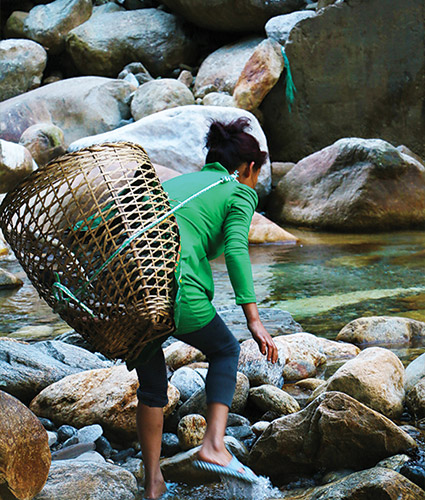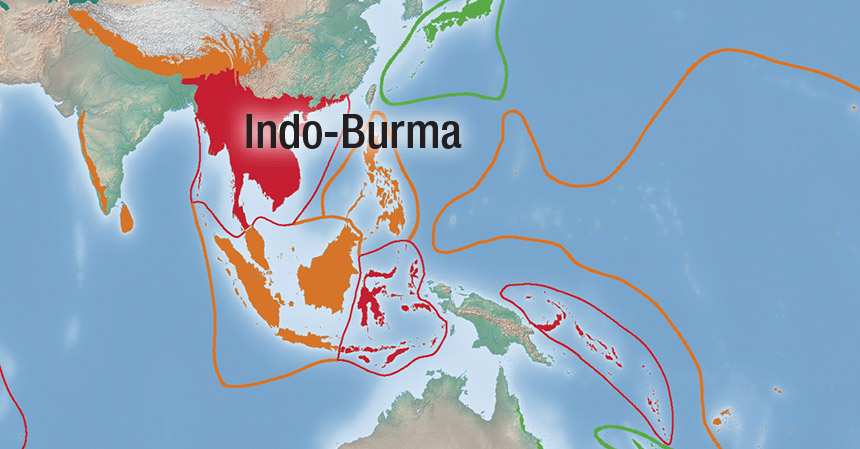Bringing Conservation into Development Decision-Making
In 2016, the Chinese national government released the 13th five-year plan, which excluded previous plans to build a cascade of large hydropower projects along the mainstream of the Nu River, China’s last major free-flowing river.
Persuading governments and industries to factor biodiversity-relevant data into development decision-making is an important component of the CEPF approach. Our strategies support grantees’ work with government and the private sector to establish policies that incorporate conservation concerns into project planning. CEPF grantees in the Indo-Burma Biodiversity Hotspot provide strong examples of the difference such efforts can make.
Myanmar
Asia’s karst landscapes—formed when limestone is eroded and dissolved over time to create dramatic peaks and caves—are reservoirs of unique biodiversity. The combination of limestone hills, dry soils and caves creates conditions that require plants and animals to adapt and evolve. Many species are restricted to a single hill or cave system, and limestone towers serve as a refuge for others.
One of the most significant threats to these unusual and vibrant ecosystems is limestone extraction for the cement industry. Environmental impact assessments (EIAs) for quarrying typically fail to fully represent the potential damage to biodiversity because the uniqueness of karst biodiversity is not understood by relevant actors, and because the species at risk from quarrying are frequently small; have no assessed threat status or protection; and lack wings, fur, or other “charisma.”
CEPF grantee Fauna & Flora International (FFI) has been working since 2014 to mainstream karst biodiversity conservation into policies, plans and business practices in Myanmar by identifying priority sites; preparing recommendations, guidelines and policy briefs in relation to the cement and tourism sectors; piloting best practices; introducing community-based cave management; and raising awareness of the value of biodiversity.
In 2016, the Myanmar government and FFI hosted the first-ever stakeholder workshop on development in karst landscapes, convening government agencies that focus on environment, forests, heavy industry, mines and energy, as well as cement companies, civil society and development banks.
At the conclusion of the workshop, one cement company invited FFI to visit their existing quarry site and to critically review the EIA that had been completed. Subsequent biodiversity surveys of the site revealed new species that likely have restricted distributions. FFI is currently working with the company to produce a new EIA as a condition for a loan from the International Finance Corporation. “I believe this is the first EIA for a major cement company that has expressly looked at limestone-restricted biodiversity,” said Tony Whitten, FFI’s Asia-Pacific regional director and chair of the IUCN Cave Invertebrate Specialist Group.
As part of its CEPF grant, FFI continues to work with Myanmar’s Ministry of Natural Resources and Environmental Conservation to finalize EIA guidelines for cement companies to ensure that future development plans appropriately consider and protect these rare landscapes.
China

The Nu (Salween) River, originating in the Tibetan Plateau and winding through China, Myanmar and Thailand to the Andaman Sea, is China’s last major free-flowing river. The Nu is part of the Three Parallel Rivers of Yunnan Protected Areas, a UNESCO World Heritage Site and an epicenter of biodiversity. This area is home to more than 6,000 species of plants and is believed to support more than 25 percent of China’s animal species.
Since the early 2000s, the government of China has considered constructing dams to harness the hydropower from major rivers, including the Nu. Chinese organizations, including Green Watershed and Green Earth Volunteers, have successfully led past grassroots efforts to protect the Nu River. But the Chinese government’s 12th five-year plan, running from 2010 to 2015, once again called for dam development on the Nu.
CEPF grantee International Rivers China has a long history of working closely with Chinese-based environmental groups. To protect the biodiversity of the Nu River, International Rivers worked as part of a consortium with Chinese groups, including Green Earth Volunteers, Friends of Nature and Green Watershed—all former CEPF grantees whose work to conserve the Nu River was supported as part of CEPF’s investment in the Mountains of Southwest China Hotspot in the mid-2000s. The consortium conducted key research, including a series of fact-finding trips. Participants assessed plants and fauna, and conducted geological studies to estimate seismicity and earthquake risk. To develop the skills of the next generation of environmentalists, International Rivers organized a learning trip that paired prominent long-time leaders of the Nu’s protection with young environmentalists.

As a result of all these activities, numerous Chinese and international publications featured stories about the importance of the region to China and to Southeast Asia. Chinese scientists and civil society organizations became better connected, and channels were strengthened for flow of information between countries upstream and downstream from the Nu.
The consortium organized a meeting with the National Energy Administration to share its findings, providing overwhelming evidence against damming the river. “In 2016, the national government released the 13th five-year plan, which excluded previous plans to build a cascade of large hydropower projects along the mainstream of the river,” said Stephanie Jensen-Cormier, China program director for International Rivers. “The provincial government announced that no further small hydropower stations could be built on tributaries of the Nu.”
Keeping in mind that insufficient financial resources to build new dams was a factor in these plans, International Rivers will continue working to protect the Nu so that biodiversity and local communities continue to thrive.
Photo Credits
A Buddhist temple near the limestone hills of Mawlamyaine, Myanmar. © Patrick Oswald/FFI
Insect found along the Nu River. © Li Xiaolong
Woman, Nu River. © Li Xiaolongy





